22. Hidden Piece Puzzles Part 1 - the Review
A detailed review of two laser-cut puzzles with over 500 pieces each from this new puzzle-maker (about 5500 words; 21 pictures)
This is the first two postings of inaugural puzzles from the new Hidden Piece Puzzles company. Part 2 will include biographical information about the artists who painted the images used for these two puzzles and walk-throughs of my assemblies of them.
The puzzle images and data
Home in the Desert 1
Artist – Shachi Kale
Designer Robert Bermudez
laser-cut 5+ mm maple-veneered poplar
531 pieces 17½” x 14½” (37cm x 44.5cm) average 3.0 cm²/pc
Grow Old Together
Artist – Gwen van Knippenberg
Designer – Robert Bermudez
laser-cut 5 mm maple-veneered poplar
505 pieces 16¼” x 1” (37cm x 44.5cm) average 2.8 cm²/pc
Introduction
These are premium-grade puzzles from a new American puzzle-maker. I learned about Hidden Piece Puzzles from the favourable buzz they got in the Wooden Jigsaw Puzzle Club discussion forum on Facebook. Hidden Piece is a small home-based company that just launched in late September of 2022.
The story of how Robert and Rebecca Bermudez got into making wood jigsaw puzzles is similar to other Covid-inspired start-ups (you can read other pandemic era origin stories here, here, and here.) It began when Rebecca was given a wooden jigsaw puzzle as a gift from her aunt in the early days of the Covid pandemic. Robert had fond memories of jigsaw puzzles from his childhood but that gift introduced Rebecca to this hobby. They were both immediately hooked on assembling jigsaws for the same reasons that it appealed to so many other people during those stressful and isolating early pandemic months.
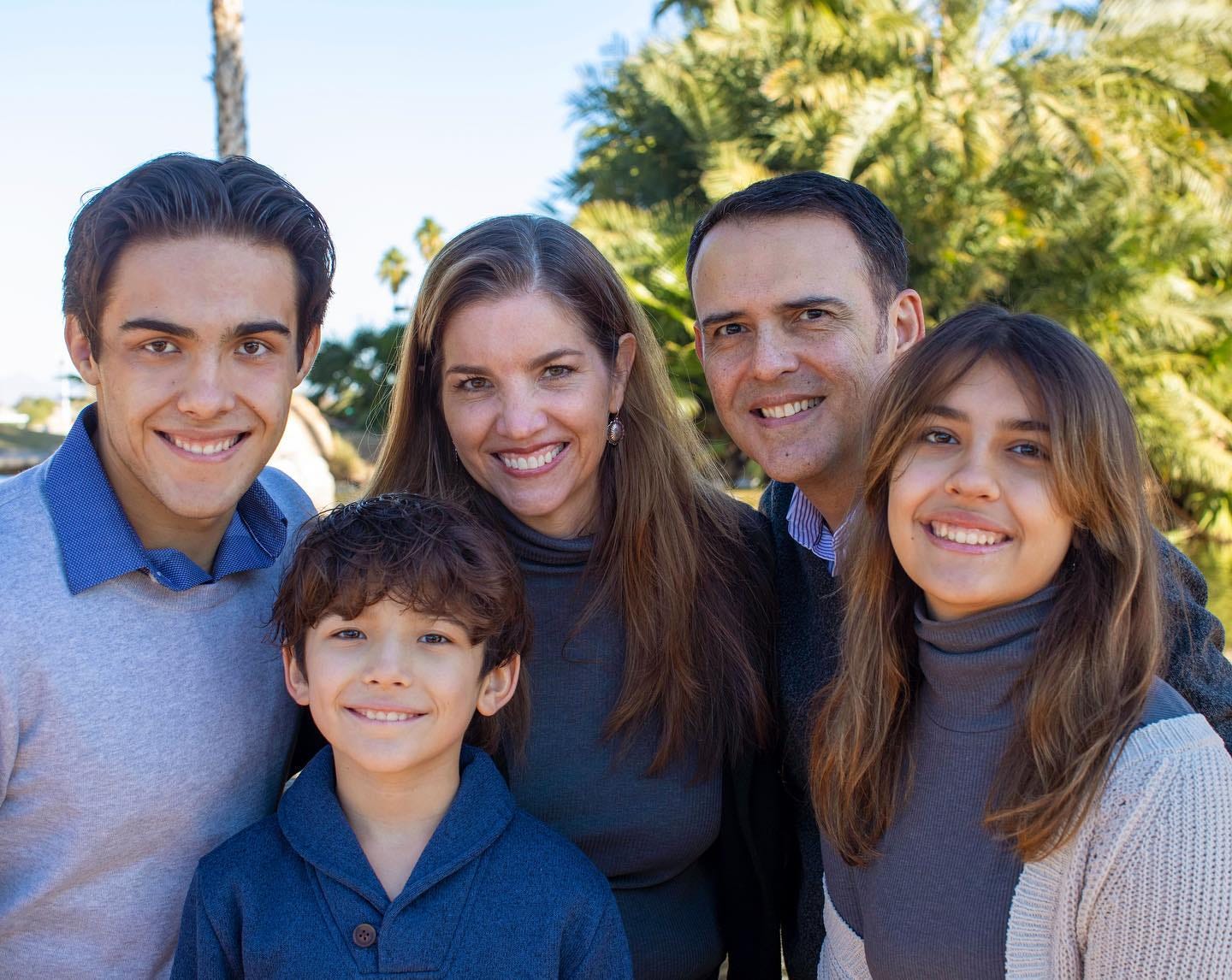
Robert and Rebecca both have degrees in Psychology, and in fact Becky’s day job is her practice as a mental health therapist. Their interest was spurred by experiencing for themselves puzzling’s stress relief, relaxation, mental stimulation, development of an enhanced ability to avoid or suppress frustration, as well as the hobby’s opportunities for problem solving. (See for example, this research report from the academic journal Frontiers in Aging Neuroscience.) Assembling jigsaw puzzles gives all of those benefits as well as being downright fun!
Robert also has degrees in industrial design and business administration, and work experience in those fields. In fact, Robert’s work in industrial design had led to promotions that took him into administration and supervision and away from the creative role role aspects of the job that he had enjoyed. It didn’t take too long before they began to discuss the possibility of him quitting that job making wood puzzles as a home business. Long story short, he is now to the primary person involved in design, fabrication and the business side of running this home-based company. It is a family joke that Robert began making wood puzzles to slow down Rebecca’s buying of them.
The name Hidden Piece Puzzles reflects those roots: The Covid pandemic caused many people to feel that they had missing pieces in their lives. Becky and Robert found that assembling puzzles seemed to help fill many of those missing pieces. But digging deeper, just like while assembling jigsaw puzzles, pieces of our lives that we cannot find might not really be missing at all - they are just hidden.
Finding something that you thought was missing always is very encouraging, whether it is in life or a piece in a puzzle. Perhaps that happened to me. I instantly fell in love with the image for Growing Old Together as soon as I saw it on their website. I had to have it! I am a collector of folk art (mostly wood carvings) and like to think that I have a good eye for recognizing the real thing. In fact, that may be why I tend to be drawn more to the wood jigsaw puzzles that are made in home workshops rather than in large factories.
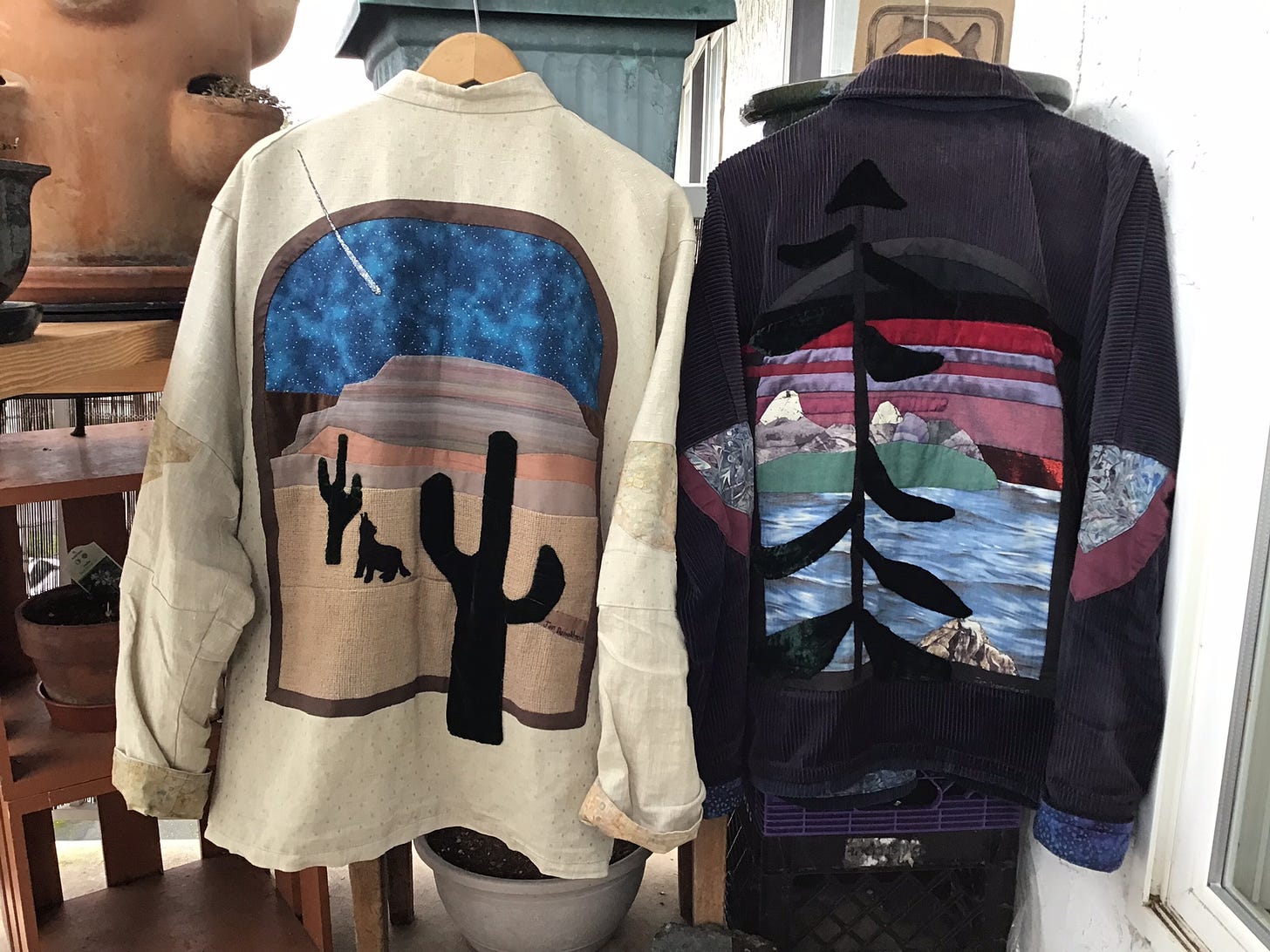
Since Hidden Piece Puzzles’ ordering system was not yet set up to ship internationally I called to see if I could arrange to have one shipped to me in Canada. (Yes, they actually have their phone number on their website, and Robert is the person who answers.) I think we were on speaker-phone because Rebecca occasionally chimed in with comments. Becky is an occasional participant in the Wooden Jigsaw Puzzles Club discussion forum on Facebook and she recognized my name.
Soon after the call was over I got an e-mail from Robert that offered to send me an additional puzzle for free to review! So that is how I got Home in the Desert 1, which I understand was their most popular puzzle at the time. Other than that I have no affiliation with Hidden Piece Puzzles or the Bermudez family.
Puzzle reviewing in general - considerations and standards
[Very long digression: It seems to me that there are three major factors that shape how much I personally enjoy assembling a particular puzzle:
The intrinsic qualities of the puzzle itself;
Whether I am in the right mood at the time to assemble a puzzle with its image, and;
Whether I am in the right mood for the degree and kind of challenge that its cutting presents.
It is possible, even likely, that the two mood factors are the most important factors in how I respond to a puzzle, but their impact is both very subjective and very personal and should not influence what I say in my review-essays. A review should be about the puzzles, not about me. (But I have to admit that I sure do incorporate a heck of a lot of ME in my rambling, quirky writing style!) So when I write my reviews I try to acknowledge and distinguish between those factors and my comments about the quality of the puzzles.
Some of the qualities of puzzles themselves are much more amenable to objectivity in analysis. That is probably why I am drawn towards analyzing puzzles while I am assembling them (see the About section of my blog), as well as why I go into such technical detail in these reviews.
It seems to me that there are also three major categories of intrinsic characteristics of a puzzle that shape how much a person would enjoy it:
The image’s artistic quality and how well it and its style matches a person’s personal artistic tastes (Extremely subjective but probably the most important factor);
The style, quality and creativity of its cutting design (Still subjective but very important for my own enjoyment); and
Technical aspects of the puzzle’s fabrication and condition.
We have the ability to self-select for these first two factors when we choose which puzzles to buy or borrow. Puzzle-makers are well aware that artwork sells puzzles. They almost always show us the image and their style of whimsies (if any) in their online catalogs. They want you to be successful in picking a puzzle with art that you will like so that you will come back to buy more puzzles from them.
Separate from showing off their whimsies they are somewhat more mixed in the extent to which they show other aspects of their cutting designs. Some show the full cutting pattern, some give limited information, and some seem to want the puzzling aspects of their puzzles to surprise you during assembly. Some self-rate their puzzles for difficulty, and some don’t.
I can understand a rationale for any of these choices. I personally prefer to see the cutting pattern before I buy and am slower to buy if I can’t do a self-selection for that factor. I appreciate that Hidden Piece Puzzles is one of the companies that does show their cutting designs on their website. My self-selection also explains my frequent references to the wooden jigsaw puzzle groups on Facebook. People who post messages there often share pictures and information that is not on the maker’s website, often with spoiler alerts about the cutting designs.
Many if not most of the puzzles that I buy are based upon recommendations from people in online groups. Experience has shown me whose perspectives I most value. My care in self-selection explains why I end up posting so many positive reviews of puzzles. In fact, in this whole series I have yet to give a puzzle what I think of as a bad review. That is because I have really enjoyed assembling every wooden puzzle I have attempted (except for Salmon’s Academy’s vintage puzzle Perfect Harmony, and in my review of that one I did not attribute the problem to the puzzle itself but to me not having been in the right mood for it at the time.)
Besides analyzing the factors that are subject to objective assessment I also have been looking for patterns in which styles of cutting designs most appeal to my own personal preferences. I want to recognize the cutting styles I like best to help me make appropriate future purchases. And after I have developed insights about that I can’t help but share them with you. Sometimes I do that in the review part of my posting, and other times that sort of content is in my puzzle walkthroughs after a Spoiler Alert.
You may have noticed that I try to include only limited photographs of cutting patterns in the review portion, but I provide much more complete information after the Alert. I know that not everyone has my amazing puzzling superpower of forgetfulness, and for many people having too much information in advance about the cutting design might detract from making their own discoveries during assembly.
Technical aspects are the oddball factor in this latter list of characteristics that are intrinsic to puzzles. In general, although I can imagine there could be so much excellence in the fabrication of a puzzle that one is blown-away by its sheer quality (many people describe the ultra-expensive Stave puzzles that way) but most of the time it is shortcomings from the expected quality that draws my attention and comments.
I probably tend to dwell more than I should on technical fabrication because of a genetic predisposition for that sort of thing. My grandfather grew up on the farm but became a machinist, inventor, and he started a manufacturing company. My father became responsible for the design and manufacturing side of that company when he got out of the Army after WWII. He innovated in that manufacturing and became an active member of the Society of Manufacturing Engineers. In time, he became the president of that organization even though he had no formal engineering education.
I wasn’t interested in design and fabrication at the time and I didn’t go into the family business. But now in my old age that interest is popping out in the form of critiquing puzzle-making all while having limited experience or education in anything related to the topic. I suppose that’s what they call irony.
Most makers (but not Hidden Piece) call their wooden jigsaw puzzles “heirloom quality” somewhere on their websites, and I suppose that all of them can be considered that if they are compared to their cardboard counterparts. For these postings I make a distinction between ones that I consider puzzles to be “premium” if they have both technical specifications and a price-point that separates them from the lower-cost “standard” category of wooden puzzles.
Makers of premium puzzles are competing against each other based more on quality than price, while makers of standard puzzles are making puzzles for a more price-sensitive marketplace. For example, I am more likely to consider puzzles that are 5 or 6 milimetres thick to be premium than those that are 3 or 4 mm thick. Because of their higher prices, the default expectation for premium puzzles is flawlessness. I cut more slack for standard puzzles. End of extended digression.]
As I write this, Hidden Piece’s laser-cut 500+ piece 5mm thick puzzles are priced at $125 USD and they describe their puzzles as being “deluxe.” My standard for comparison for them is therefore other similarly-priced (for their size) puzzles, which pits this new company against the very best laser-cut puzzles available.
I can only compare to brands that I have already assembled myself. In this case, my comparison includes puzzles made by Artifact, Nautilus, Stumpcraft, and DaVICI. That is fine company to keep – all of them are well-known, well-established brands that make very fine puzzles. But they do set a very high standard for a new puzzle-maker to match. (Note: Liberty Puzzles is probably the best-known company in the category of premium laser-cut puzzles but I haven’t done one of theirs yet.)
I won’t hold you in suspense. Hidden Piece Puzzles not only deserves to be grouped together with those other great laser-cut wooden puzzles, theirs are among the very best!
Packaging and first impressions
I must admit that I have mixed feelings about the high-quality boxes, bags and other features that premium puzzles come with. I know that impressive packaging is an important feature if the puzzles are to be gifts, but I buy them for myself and am quite price-sensitive. There is part of me that would prefer that they be sold in simple cardboard boxes suitable for safe storage, and for that the cost-reduction be passed along to me as a lower price.
On the other hand, I do appreciate high quality, and a well-designed box, a storage bag and other touches of grace and style. That probably does get me started on the right foot, ready to enjoy the luxurious experience from the relatively few puzzles of this caliber that I can afford to indulge in. And luxuriant experience is what I want from wooden puzzles. So as I said, I have mixed feelings about packaging.
Hidden Piece puzzles come in a very attractive drawer-style box, made from thick dense cardboard that is covered with textured paper that seems to have the quality of fine stationary. The drawer has satin ribbon pull-tab. The weight of the empty box with its drawer is almost as heavy as the extravagant wood boxes that Artisan uses (and which for a while was the standard packaging for Stumpcraft Puzzles.)
The cover includes a picture of the puzzle’s image, with another small thumbnail picture on the end for easy reference when the box is on a bookshelf. The text is informative without seeming busy. On the back of the box is information about the artist and a sneak-preview of some of the figural pieces in the puzzle. The bottom of the drawer has a log to keep a record of the many people who will assemble the puzzle over the years. Hidden Piece doesn’t describe its puzzles with the over-used phrase “heirloom quality” but that is clearly what they are aiming to be.
Inside, the puzzle pieces are surrounded by tissue printed white-on-white with the company’s logo. There is also a velour bag for extra-secure future storage, and inside that is a poster for those who want to use one for reference during assembly.
Overall, I think that Hidden Piece puzzles have the most elegant packaging of any in my collection.
Puzzle fabrication - the technical side of puzzle-making
One of the first things I noticed when opening the box was that the campfire aroma that usually accompanies any laser-cut puzzle is greatly subdued, and the edges of the pieces appear brown rather than black. I asked Robert Bermudez about this and he explained that he has installed much more powerful exhaust fans to draw smoke away immediately so that it will not cling to the pieces. He also burns away less material than most other puzzle-makers – more about that later. However he achieves it, the puzzles do have the familiar campfire smell that many puzzlers love and a few of them hate, but not as strong as that of most other laser-cut puzzles
The material is 5mm thick plywood, with maple as the outside and one thick ply of poplar hardwood in the middle. Maple is very hard and makes for a very smooth durable surface. Yellow poplar (also known as tulip poplar or tulipwood) is durable and fine-grained. It is technically a hardwood but it weighs only about 60% as much as the birch plywood or MDF (medium density fibreboard) that many of the other premium puzzles are made from. In fact, tulip poplar is about the same weight-by-volume as basswood, which is the wood that most Chinese puzzles are made from (and about which I commented in this review.)
I can’t say that the lighter weight of the pieces of these puzzles was noticeable during my assembly, but because of that and the fact that Hidden Piece puzzles are 5 rather than 6mm thick their pieces do not have quite as much heft as some other premium puzzles (such as Stumpcraft.) But possibly because of the extra hardness of the maple veneer and the intricacy and gentle swirling of Robert’s cutting design for the non-whimsy pieces (which I will discuss below under Cutting Design) the weight and thickness of the pieces seemed fully satisfying.
I recently had a brief online chat with Maryline Ehlermann who cuts hyper-delicate and fragile patterns in her 3mm thick MDF ClairDeBois art puzzles (which also fall into the “premium” category of quality and price despite their thinness.) She made a very persuasive case that thick robust pieces are not better if what you are aiming for is delicacy. She also argues that the hefty weight and thickness of a piece in people’s hands might outweigh the message that there eyes send to their brains about the need for extra caution when handling her finely-cut pieces. She uses 3mm MDF for her premium-priced puzzles, not as a cost-saving measure but because it is the right material for her art-piece creations.
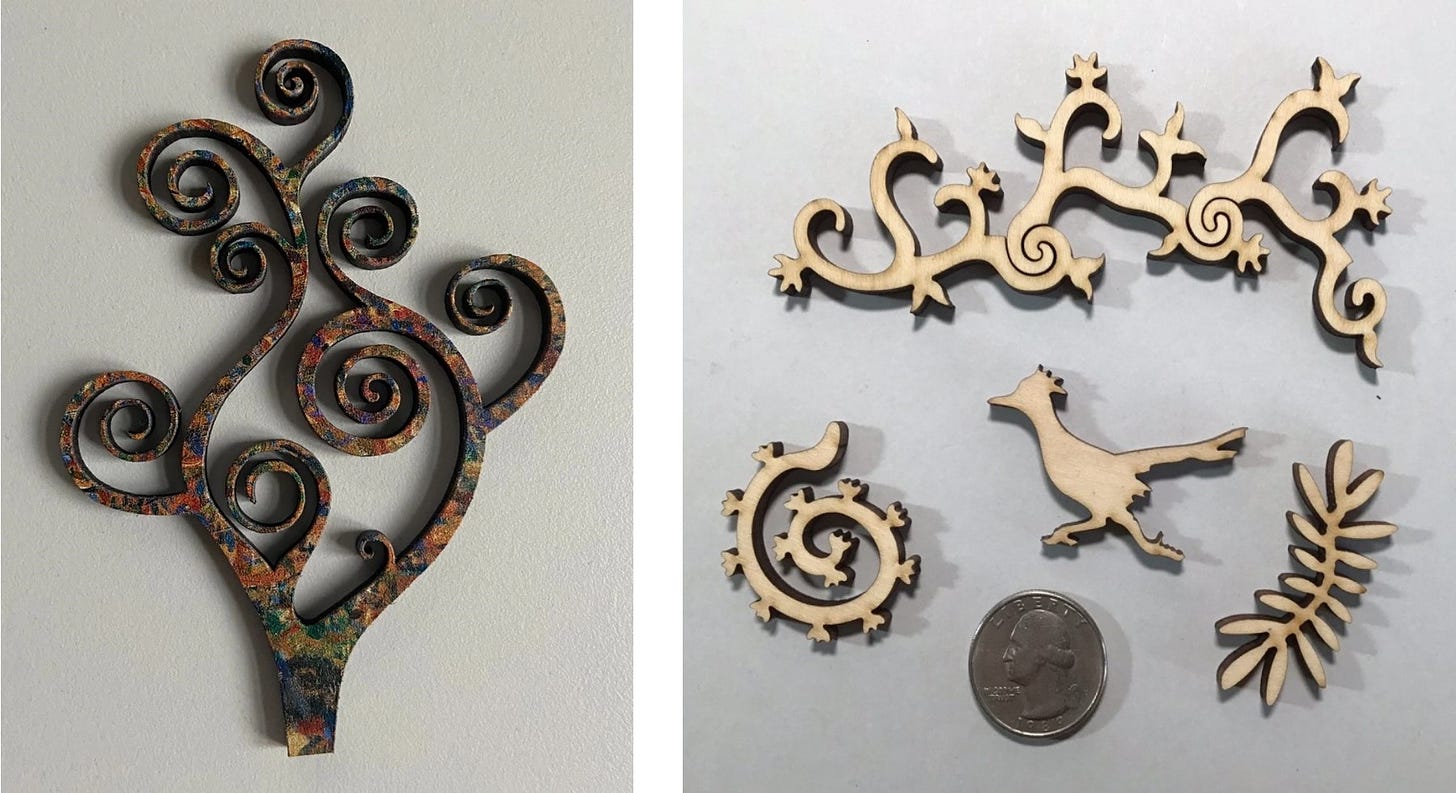
That would seem to apply to Robert’s cutting designs too. My first thought had been that his puzzles would be even better if they were 6mm thick and made from heavier ply or MDF, but I have since changed my mind about that. His cutting designs are not as delicate and fragile as some of Maryline’s (and I can tell that he takes great care to avoid having weak spots that would be susceptible to breakage) but much of his design has a delicacy in its impact. I now think that their thickness and weight seem perfect for both his intricate whimsies and the baroque character of his non-whimsy pieces. To use a wine analogy, one wouldn’t want a Chablis to have the full-bodied heft of a Burgundy.
Another technical factor that was quite noticeable once I began assembly is that Hidden Piece Puzzles’ pieces fit more tightly together than other laser-cut puzzles. The appearance of the completed puzzles is almost like that of hand-cut ones. All jigsaw puzzle cutting involves the loss of material when the swath is cut, whether it is done with a saw or a laser. In the case of a scroll saw the wood is turned to sawdust and with a laser-cutter it is turned into char and smoke. The width of the “kerf” from a scroll saw blade is only about 0.012” and no laser can cut that narrow of a swath.
Robert told me that the narrowness of the kerf of Hidden Piece Puzzles is partly because he uses a particularly high-quality laser cutting machine, and that he sets its power and speed to a level that minimizes the amount of burning that takes place while still cutting all the way through the wood. This results in some spoilage if/when there are hidden places in the poplar layer of the plywood that have additional density (e.g., knots) where the laser does not cut clear through. Having the occasional incomplete burn-through means that the puzzle is ruined and must be thrown away, thus raising his costs. But that is one of the choices that enables him to make puzzles that are indeed “deluxe.”
Also, Robert cuts his puzzles from the back side to the front. The kerf from a scroll saw blade is the same from the top to the bottom of the cut. But the kerf from laser cutting is wider on the side that the laser is coming from (since the wood is burning for milliseconds longer on that side) than it is on the side where the laser beam emerges. The result of Robert cutting from the back side is that while the swath doesn’t look particularly narrow when viewed on the back of the puzzle, it is nearly invisible when seen from more than a few feet away when viewed from the front.
From a technical perspective everything about both of these puzzles was top notch. There were none of the teething problems like front-side scorching or smudging that I have found in some puzzles made by puzzle-makers who were still on the learning curve of working with their high-tech equipment. Even the brown aura seen around the cut-lines on the back side of these puzzle is sufficiently even that I think it enhances rather than detracts from the view of cutting pattern. Back-side scorching appears in most wood puzzle brands, and even some of the most well-regarded premium puzzle-makers cannot suppress it to this same degree. I don’t consider back-side discolourization, even when it is more severe than this is, to be a flaw (but I do give kudos to those that can avoid or minimize it like these do.)
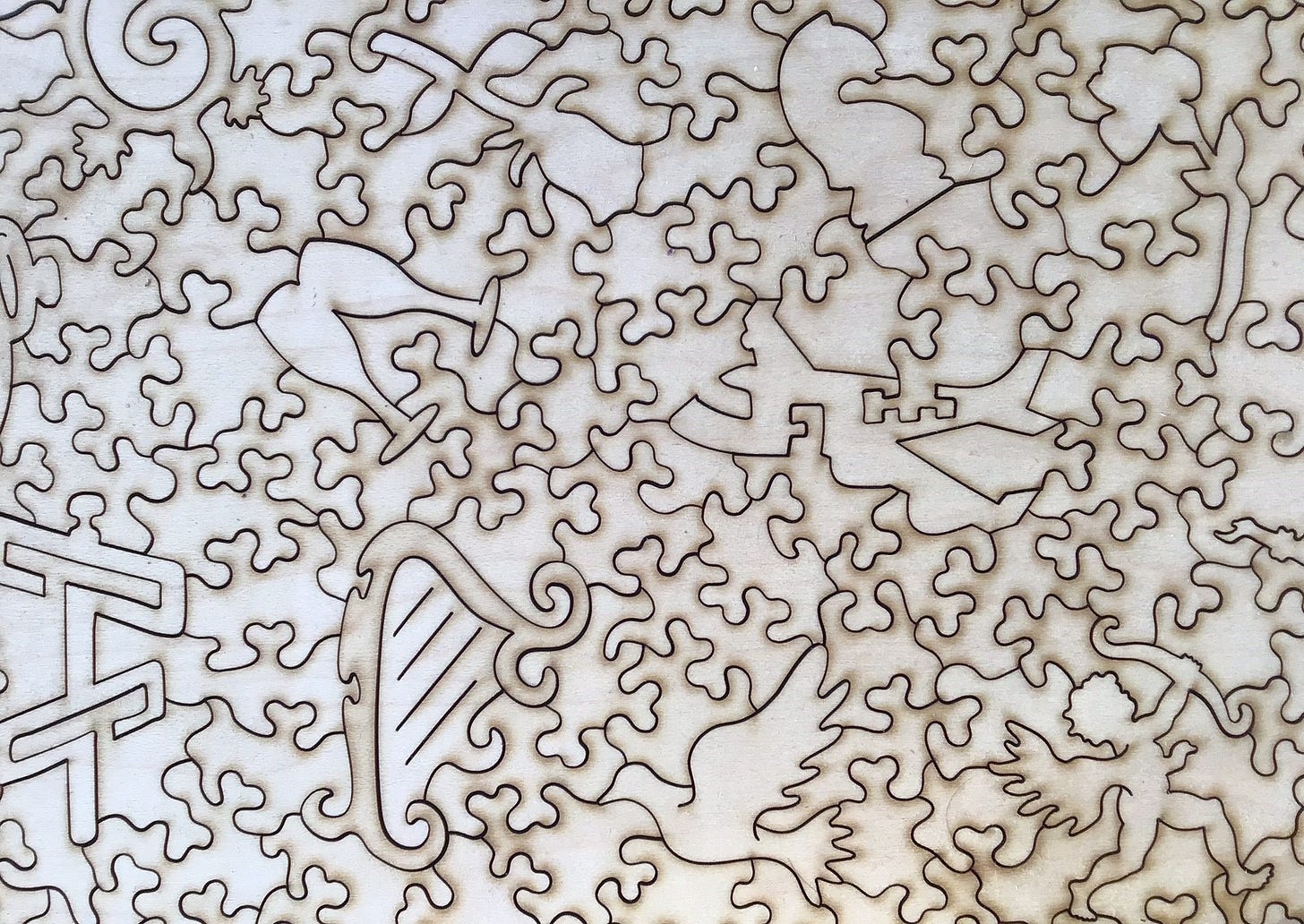
The printing is also perfect – the very high resolution non-reflective image is UV printed directly onto the smooth maple veneer. I have often explained in other reviews of UV printed-on-wood puzzles (here for example) why I like this technology better than printing onto paper for most types of images.
In both of these puzzles I did not see the 3D brushwork effect that I sometimes find in Stumpcraft puzzles, but that might be because of the matte finish or because of the original artwork for these puzzles (the brushwork effect is most effective when the image is a highly textured oil or acrylic painting.) Having a matte finish is very beneficial for reducing glare from a puzzle but it does reduce the sharpness of images, which is not an issue for these puzzles’ artwork.
All in all, Robert’s training and background in product design shows. Even though these two puzzles are among the company’s earliest releases they fully live up to the standard of perfection that is expected from premium-priced puzzles made by well-established wood puzzle-makers.
Images and selection
Probably the most important factor by far in whether someone would enjoy a particular puzzle is how much they like the image, and that comes down to personal tastes. Different people are drawn to different styles of art or different images, and that is why it is good for a puzzle company to have a large selection to choose from.
Unlike cardboard puzzles that are commonly sold in stores, wood puzzles are mostly sold online by their makers. The large well-established puzzle-makers have many different images and styles of artwork, as well as different sizes of puzzles for us to choose from. They have developed many puzzles over the years and they don’t even need to keep them all in stock to fill orders. Most of their puzzles come in standard dimensions for which they always have pre-primed blank substrates available. They can print and cut any puzzle in their catalog within days or even hours after an order is received.
Liberty Puzzles is the oldest and largest of the premium laser-cut puzzle-makers. Two years ago I read that they have 700 puzzles in their on-line catalog and they may have more now despite the fact that they occasionally discontinue some. (Note: Wentworth Wooden Puzzles is an even older company than Liberty, and they seem to have even more puzzles available. They recently reported that they developed 650 puzzle designs last year alone! But I classify Wentworth as being in the “standard” rather than “premium” price and quality category.)
New and small puzzle-makers also can make puzzles to order if they don’t already have one in stock when it is ordered, but they cannot come close to matching the larger companies for diversity and quantity of offerings in their catalogs. Most, like Hidden Piece Puzzles, are one-designer workshops and it takes a long time to come up with a new high-quality puzzle design. As I write this, Hidden Piece has been in business for about 4½ months and has released puzzles with seven images. [Update: As of May 2024 they have 13 images.]
[Note: Until recently all of Hidden piece’s puzzles were available only in one 500+ piece size-range. They have now released a 361-piece version of Grow Old Together and I understand that Robert is working on reduced-size cutting patterns with accompanying lower prices for other puzzles in their catalog.]
As I already said, I was instantly taken in by the image of Grow Old Together, which was painted by Dutch folk artist Gwen van Knippenberg so I wasn’t surprised that I enjoyed assembling it. But I was surprised by the waves of warmth and comfort I felt, and insights I got, from this particular painting (and by her many other wonderful paintings now that I have learned about this artist.)
As my assembly progressed I felt like I was getting to know this kind elderly couple and their rural home. When I studied the other paintings on the artist’s website I thought I sensed a strong autobiographical theme in them. In my mind, this image is not just any elderly couple – it is Gwen looking ahead towards her own future with her husband, and the red farmhouse home in the distance is the same one that shows up in other paintings by her.
Robert’s whimsies reinforce this interpretation by depicting the couple’s long and happy life together. Whether or not my interpretation is factually correct doesn’t matter. What is important is that I got a lot of entertainment, as well as insights and personal growth, from the time I spent watching this image come together in puzzle form. It drew a stronger response from me than any other puzzle I have assembled.
I also enjoyed Shachi Kale’s image Home in the Desert 1. Its artistic style is also very reminiscent of folk art and the artist’s love of the desert environment shines through (which Robert Bermudez’ whimsies highlight.) But I can’t say that I got as much personal engagement with this image as I did from Grow Old Together. I suspect that if I were to have experience living or travelling in this desert region of the American Southwest I would probably have had a more profound response to the image. But I accept that from an assembly point of view it might actually be a better puzzle image than Growing Old Together which has a LOT of green. Desert has delineations of distinctive colour and texture pattern regions that make for good puzzling.
[Note: There will be more information about the artists in Part 2.]
The large established puzzle-makers are able to provide one-stop-shopping for puzzles because they can offer a large quantity and diversity. There is nothing that Robert and Becky can do to match them at at the current stage of their company’s development. Adding to their offerings takes much more time than just selecting good images, and I wouldn’t want them to begin taking short-cuts to try to grow their selection quickly. Robert needs to develop a unique challenging and complementary cutting design for each one. That takes time. But I have no doubt that he and Becky will find more artwork that will appeal to me, and that will inspire me to share more of my pension with them (and with the US Postal Service because shipping costs to Canada constitute a significant portion of puzzle costs for me.) [Update: As of May 2024 they have 13 images in the 500+ pieces puzzle size, with many of them also available in smaller sizes.]
Shopping for puzzles from various small/new puzzle-makers’ websites is a very different experience than just choosing from the catalog of a large company. At the very least, you get a feeling of connection to the craftspeople who transform paintings into works of art in this different medium. I suggest that you look at the images of Hidden Piece Puzzles’ offerings to see if their current offerings appeal to your own artistic tastes.
Cutting design
This is where Hidden Piece Puzzles really shine! Robert’s cutting designs are very generously endowed with both single- and multi-piece whimsies, and the cutting of non-figural pieces gives each of them an interesting shape in its own right.
I counted 55 figurals in Home in the Desert 1, eleven of which are multi-piece. All them relate to the desert environment or its recreational opportunities. Mostly, as you can see above, their outlines are sufficiently recognizable that they do not need accent cutting for enjoyment or identification. Some of the pieces that were in featured locations as if they are whimsies are either abstract designs or shapes that I could not identify (perhaps they are inspired by Native Indian petroglyphs or pictographs.) I appreciate Robert’s choice not to include unneeded accent lines. Even though his cutting is as inconspicuous as laser-cutting can, be cut-lines inevitably add additional busyness that detracts from appreciation of the image on completed puzzles.
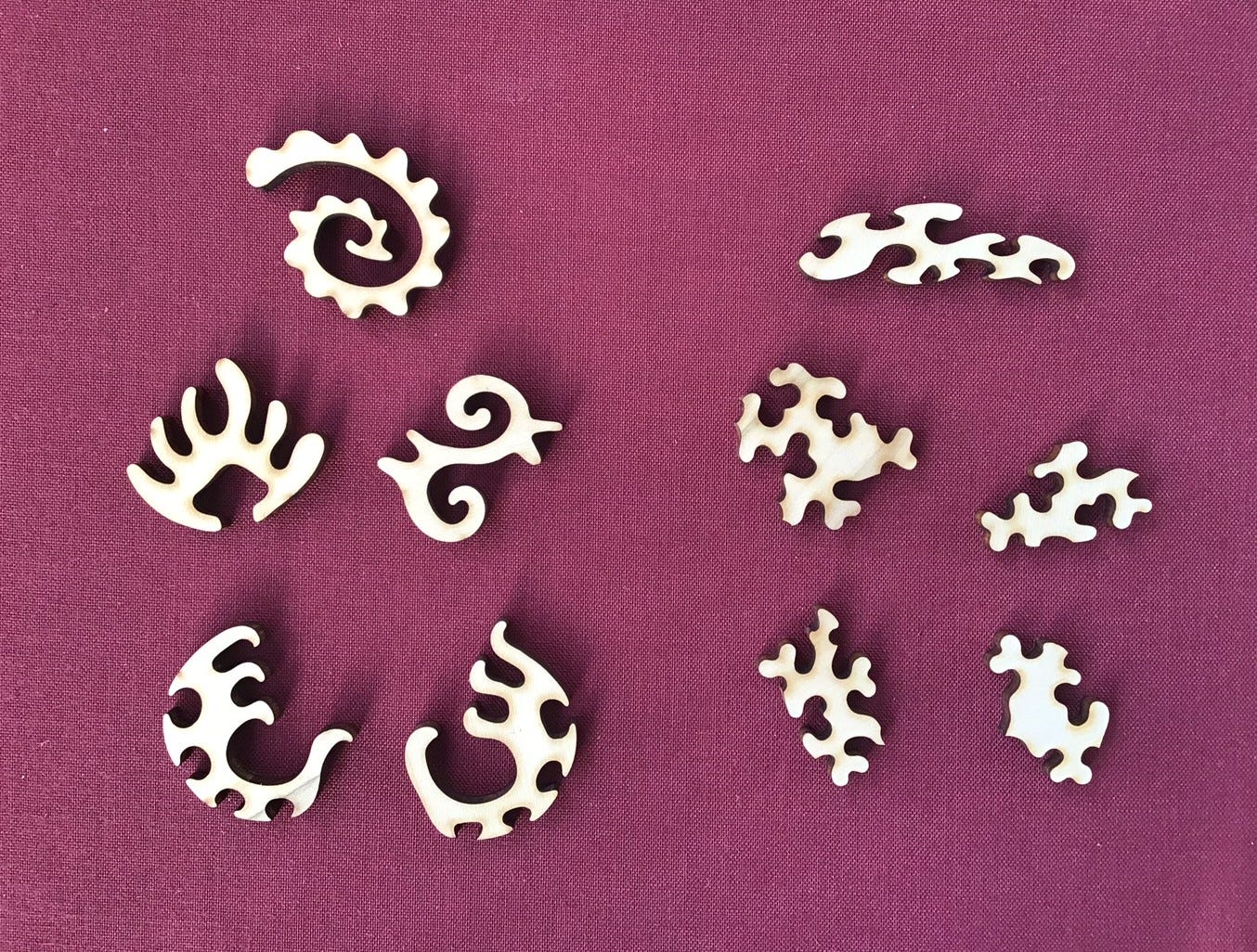
The figural pieces in Grow Old Together are similarly abundant and beautiful, and in that case they collectively tell a life-story of the couple’s romance. I found the relationship between the image and the story from the figural pieces to be quite moving.
Someone in the Facebook group posted that the image on the website of these frail old people made her feel sad. I can understand why a young person might see it that way. (For me, anyone under the age of 60 is a young person!) But that is the genius of Robert and Rebecca’s puzzlecraft. The figurals depict a now-frail elderly couple’s rich treasury of memories. When I posted the following photo as a reply to that person’s comments it changed her mind about the mood of this image and puzzle.
A couple of the whimsies in Grow Old Together were re-used from the earlier Home in the Desert 1, but they are fully consistent with the image and theme in both puzzles. That kind of re-use of figural piece patterns is very common in wood puzzle cutting designs, both hand-cut ones and laser-cuts. None of the whimsies in these puzzles had the out-of-place feel that I sometimes get from some of the ones in many other companies’ puzzles.
In both puzzles the figural pieces are upright in relation to the image (Nice touch!) and their location in the puzzle often has a meaningful relationship to other whimsy pieces and/or to the image. Discovering those relationships was a lot of fun. Sometimes I noticed them while assembling the puzzle, sometimes it was only after the puzzle was completed and I saw the back side. When I was interviewing him for this essay-review Robert told me about a couple such relationships that I had missed. There are a lot of layers of discovery in Hidden Piece Puzzles and the ability to re-discover or keep discovering new ones bodes well for future re-assembly.
There is one truly outstanding instance in Grow Old Together of a perfect relationship between the placement of a very large multi-piece whimsy and the image. It isn’t really a secret since it is shown on the Hidden Piece Puzzles website and on the back of the box. But I hadn’t seen it in those places and I was thrilled when I discovered it for myself during assembly. So I am not going to tell you about it here above the Spoiler Alert. You will be able to see it at the very end of Part 2 or here.
The beauty of Robert’s cutting designs is not limited to his figural pieces. Increasingly I am coming to realize that the cutting of non-figural background in-between pieces is very important to my enjoyment of puzzles. Both of these puzzles have a similar style of cutting for those. There are no straight cut-lines, and “earlet” shaped connectors are abundant to make the pieces interlocking. This is a variation of my favourite cutting style to date. I have taken to thinking of it as “baroque” (and ironically it is the cutting style used in the vintage Salmon’s Academy jigsaw puzzle that is the only one that I need to give up on because it was too difficult for me at the time. You can read about that here.)
Baroque cutting has two big benefits: First, the constant curviness makes all of the background pieces into lovely and ever-varied convoluted shapes that are quite interesting in their own right.
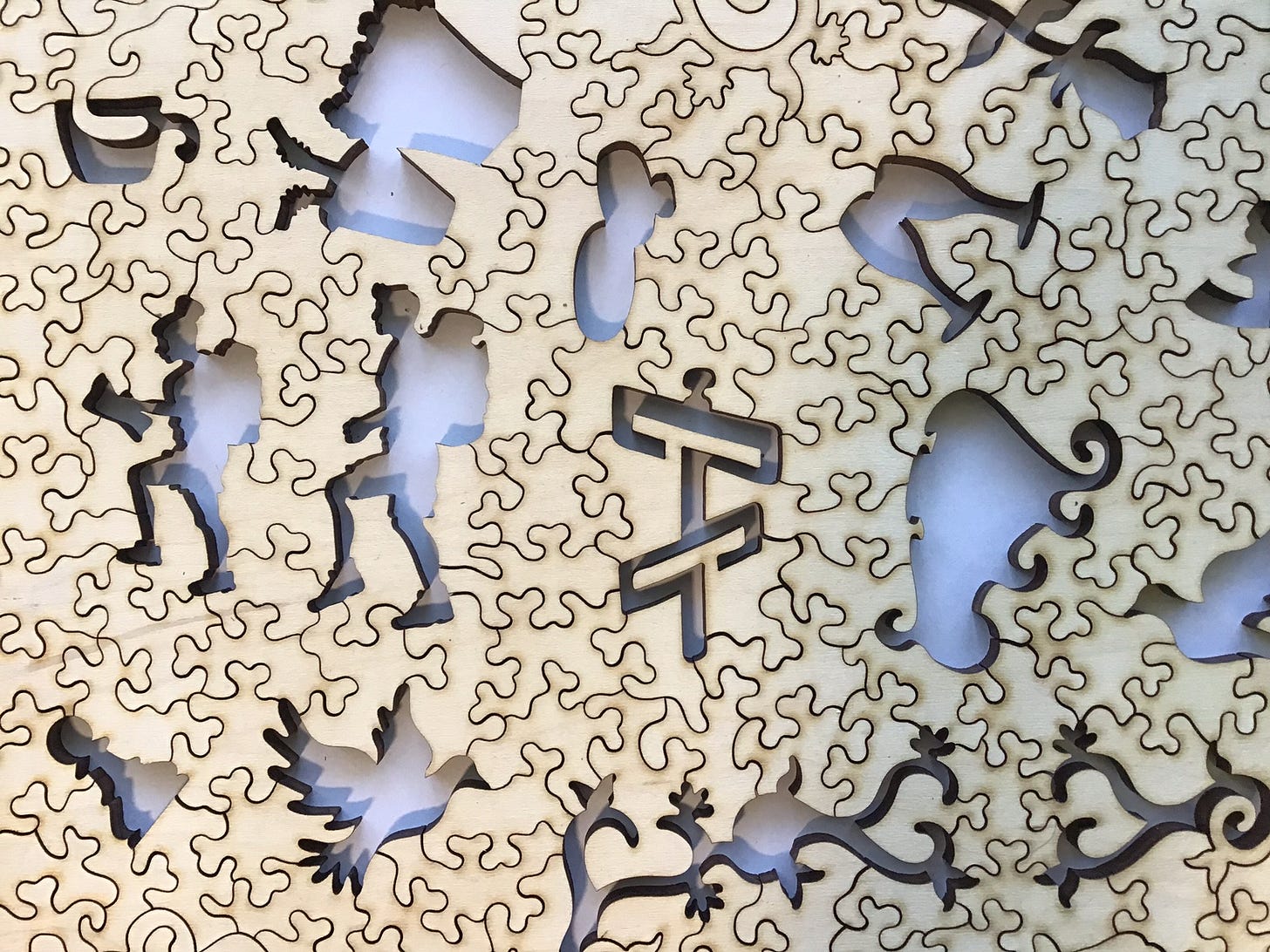
Second, all of this convoluted cutting and the recurring use of the same “earlet” style of connector makes the puzzles more challenging to assemble. This more than compensates for the simplifying effect that comes from having so many whimsies. The busyness in the cutting helps disguise matches. I had many laugh-out-loud moments when I was finally able to find the right piece for a place, or the right place for a piece.
But my preference for this style of cutting, just like my love of folk art, isn’t shared by everyone. I know that some people prefer the predictable familiarity of what might be called classic grid jigsaw cutting that results in squarish pieces with a single knob connector emerging from each side. Such folks might find Robert’s tricky cutting to be too challenging.
Review conclusions
Well, I gave away the ending even before I began the review part of this essay. For me, these two puzzles have been among the very best one ones that I have assembled so far, and in fact Grow Old Together is my favourite puzzle to date!
Proof? I’ve already bought another Hidden Piece puzzle and to hell with my puzzle budget: I fully expect to buy more as they come out with new ones with images that suit my tastes. I highly recommend that you check them out for yourselves.
I will post Part 2 of this review of these Hidden Piece puzzles in a few days. It will include information about the artists, explanations and lots of in-process photos of my assembly of the puzzles, and insights into what I have learned from those experiences.
.




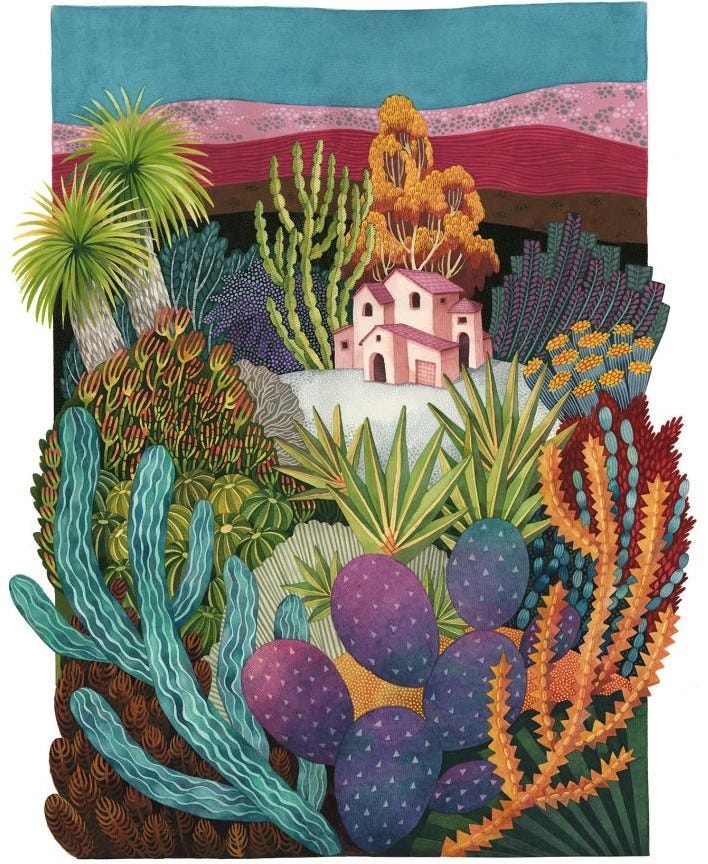


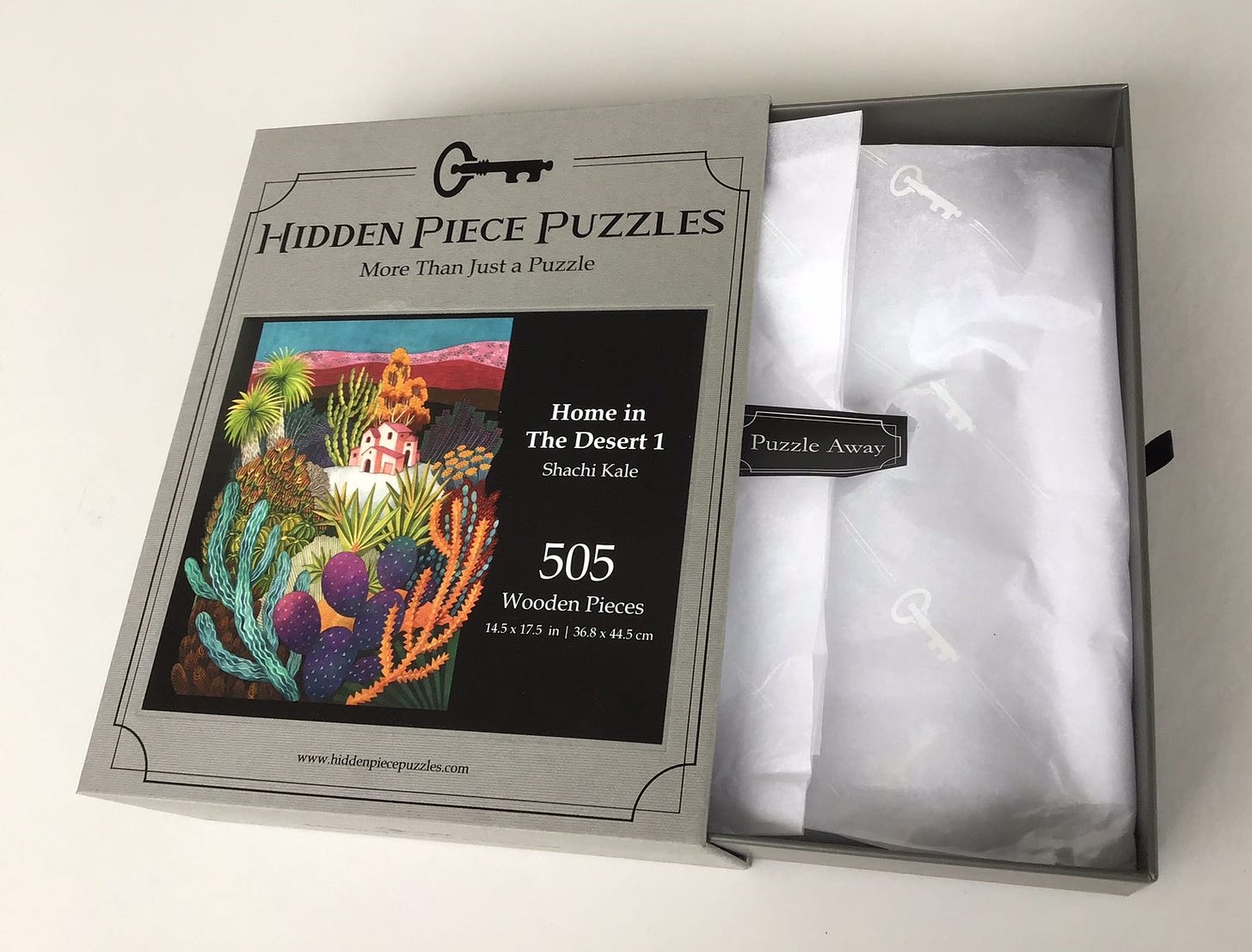
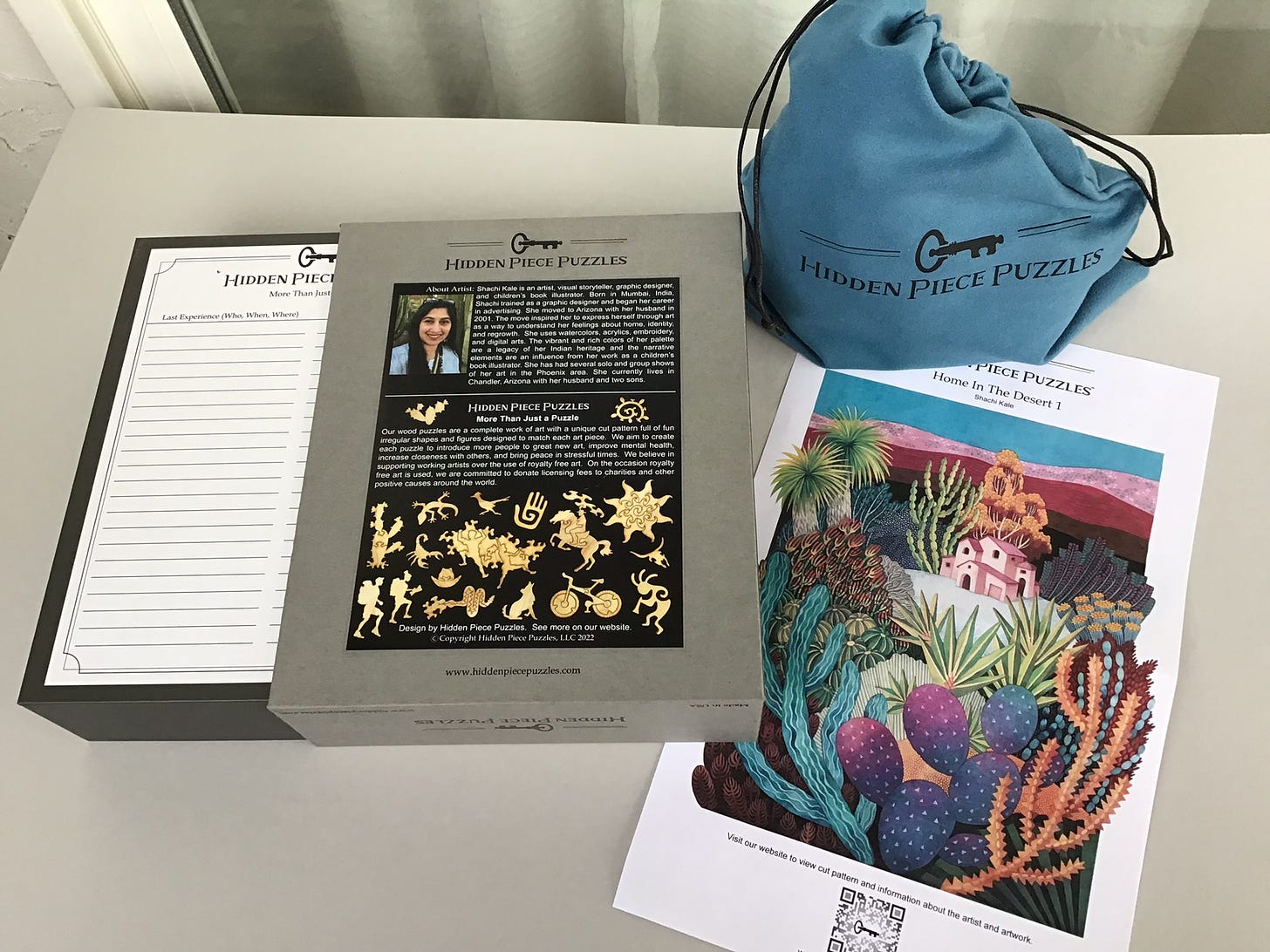
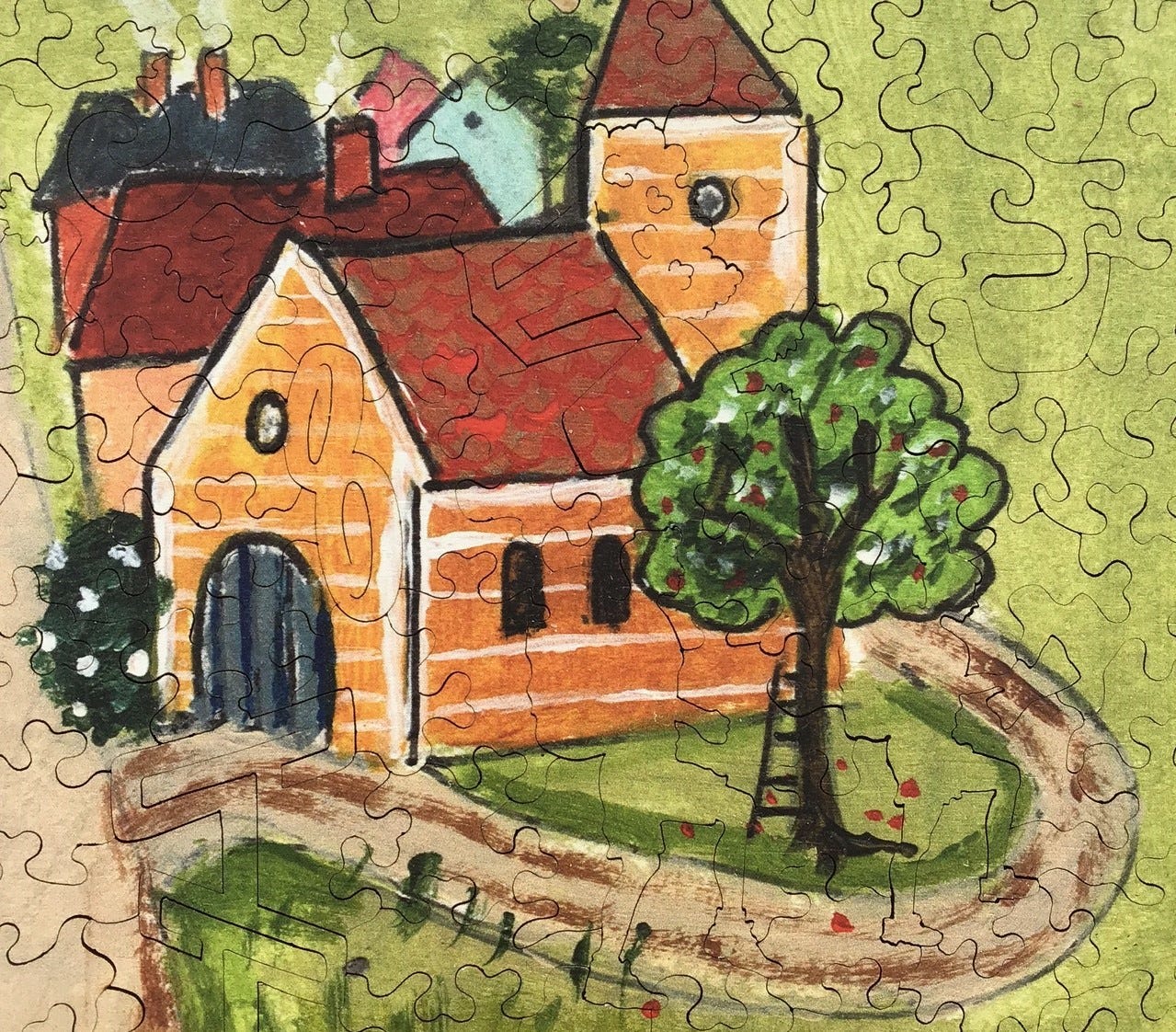
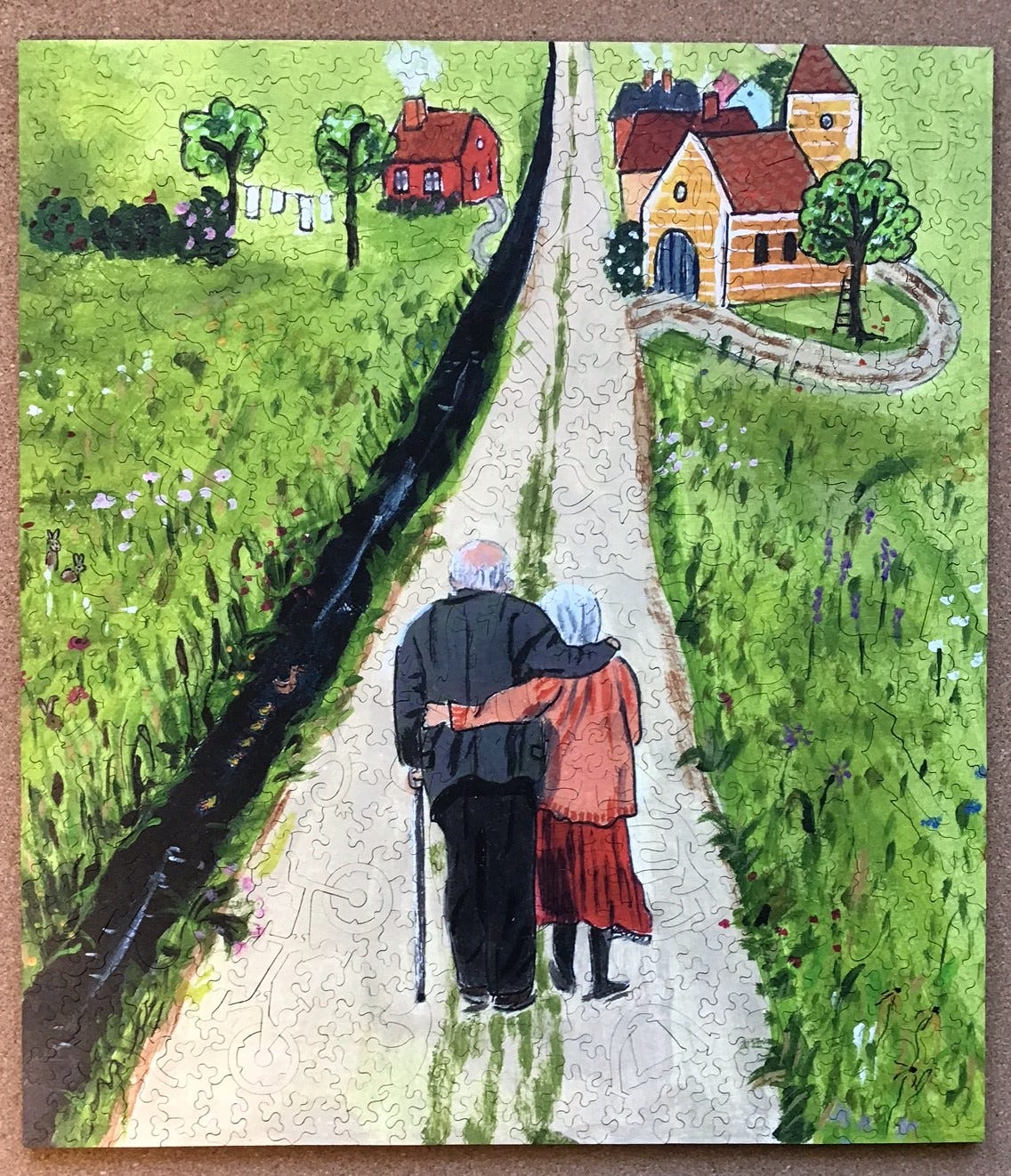
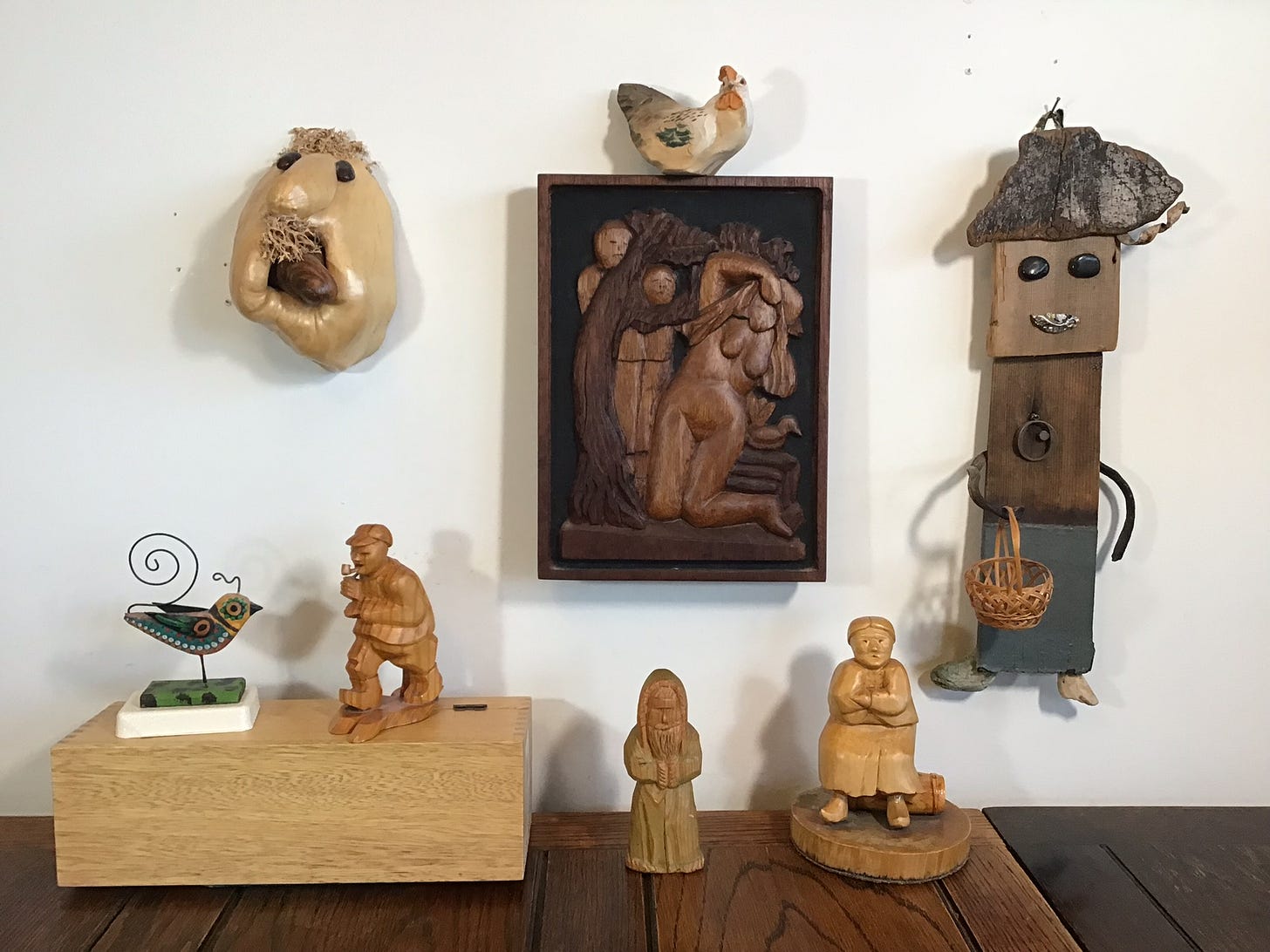
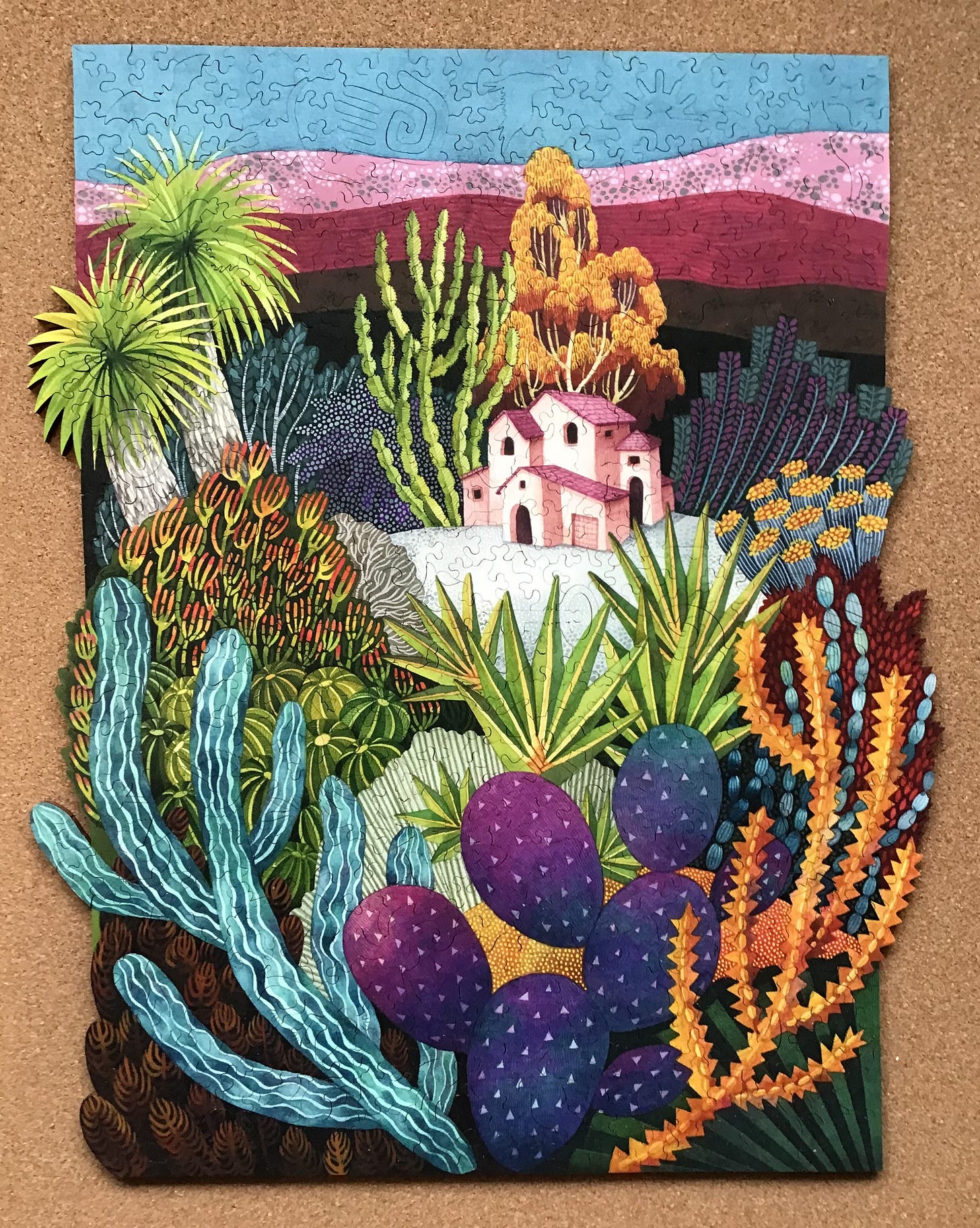
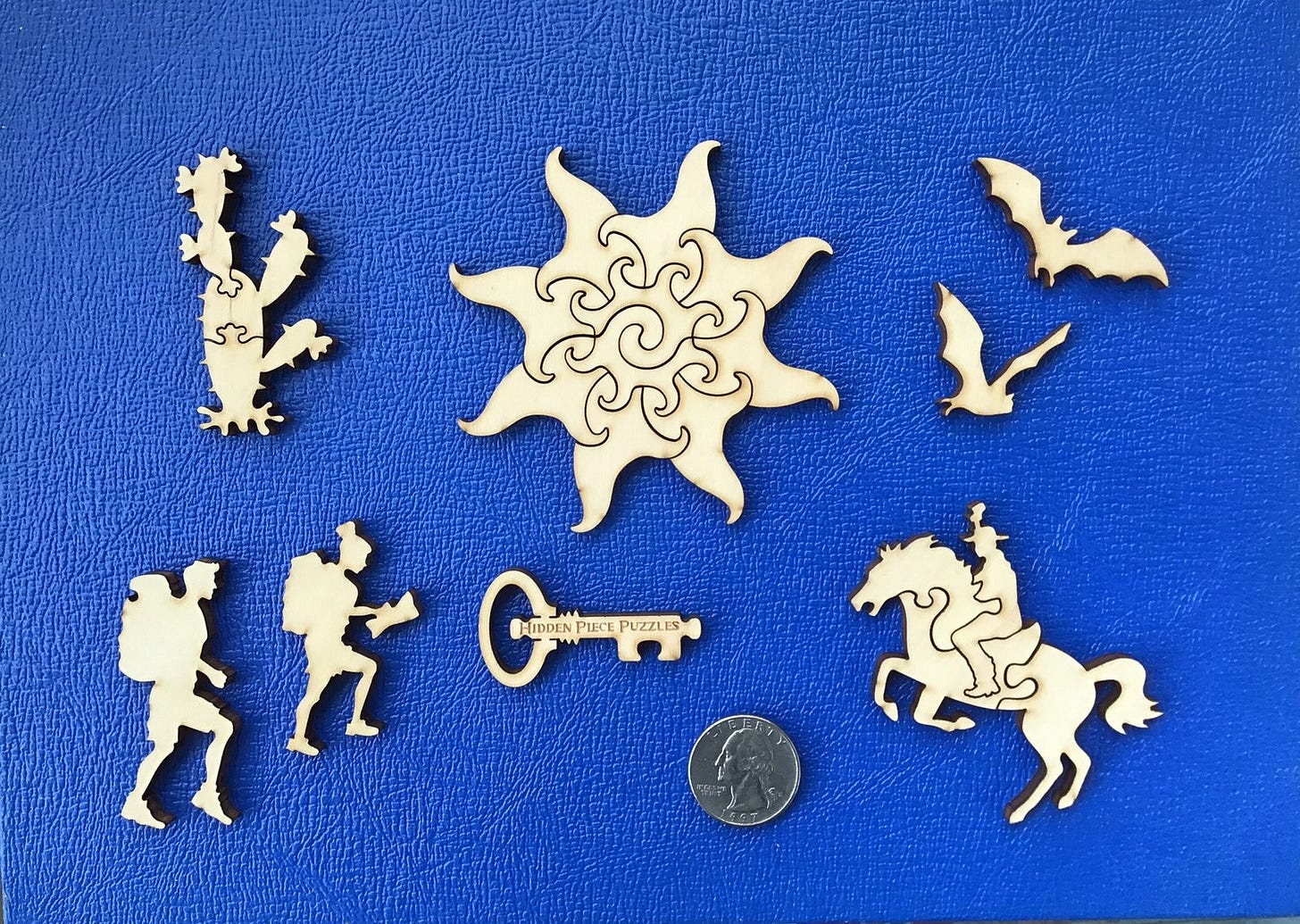
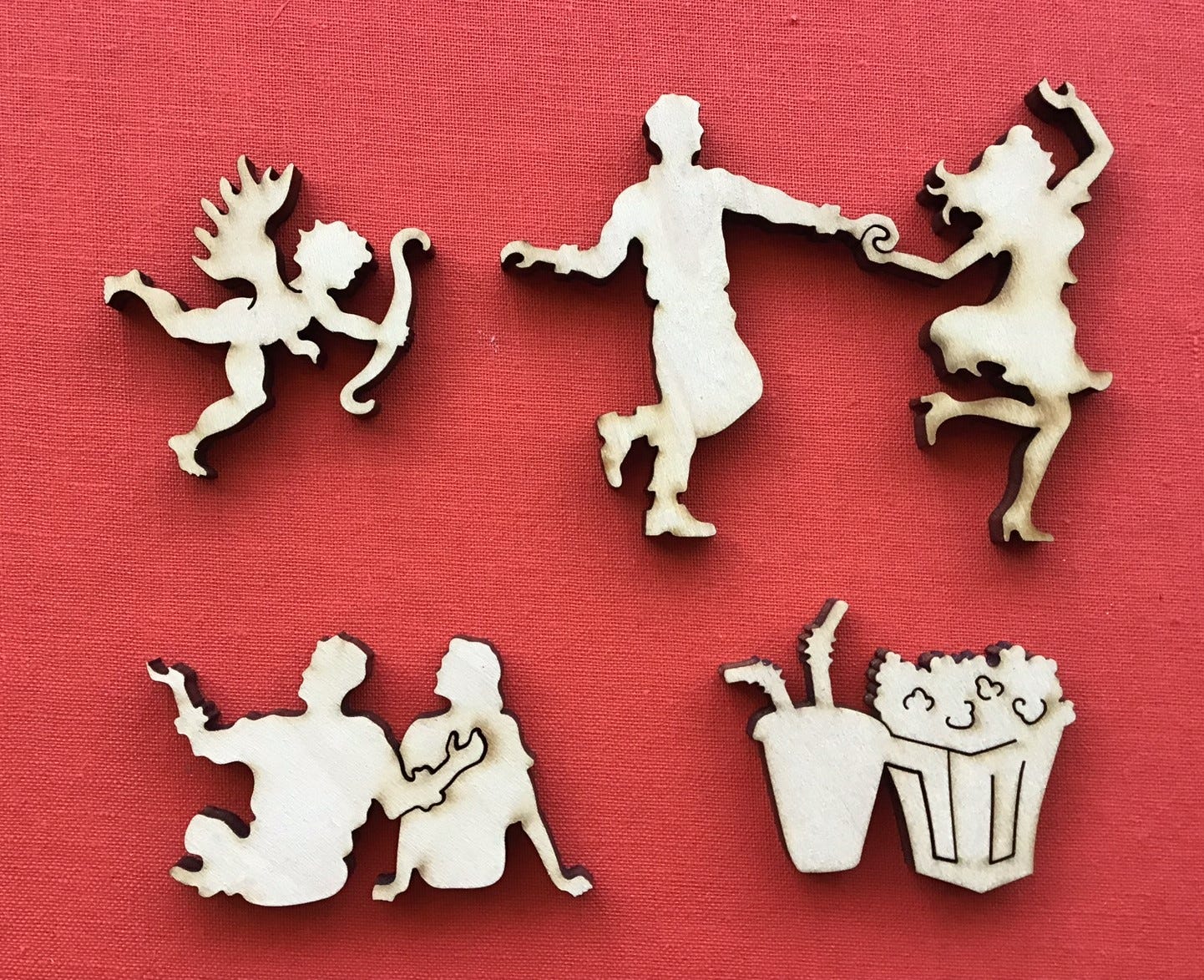
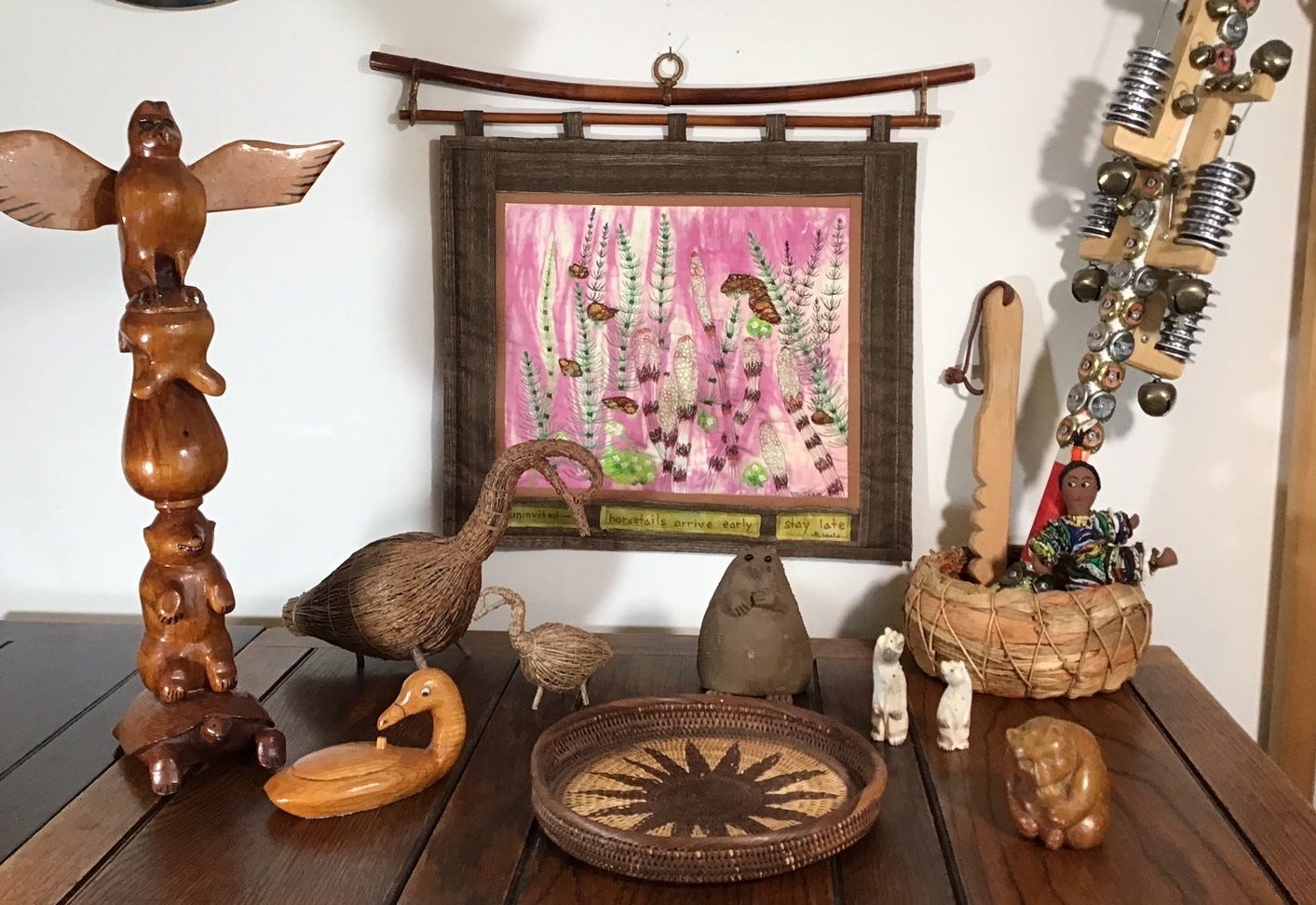
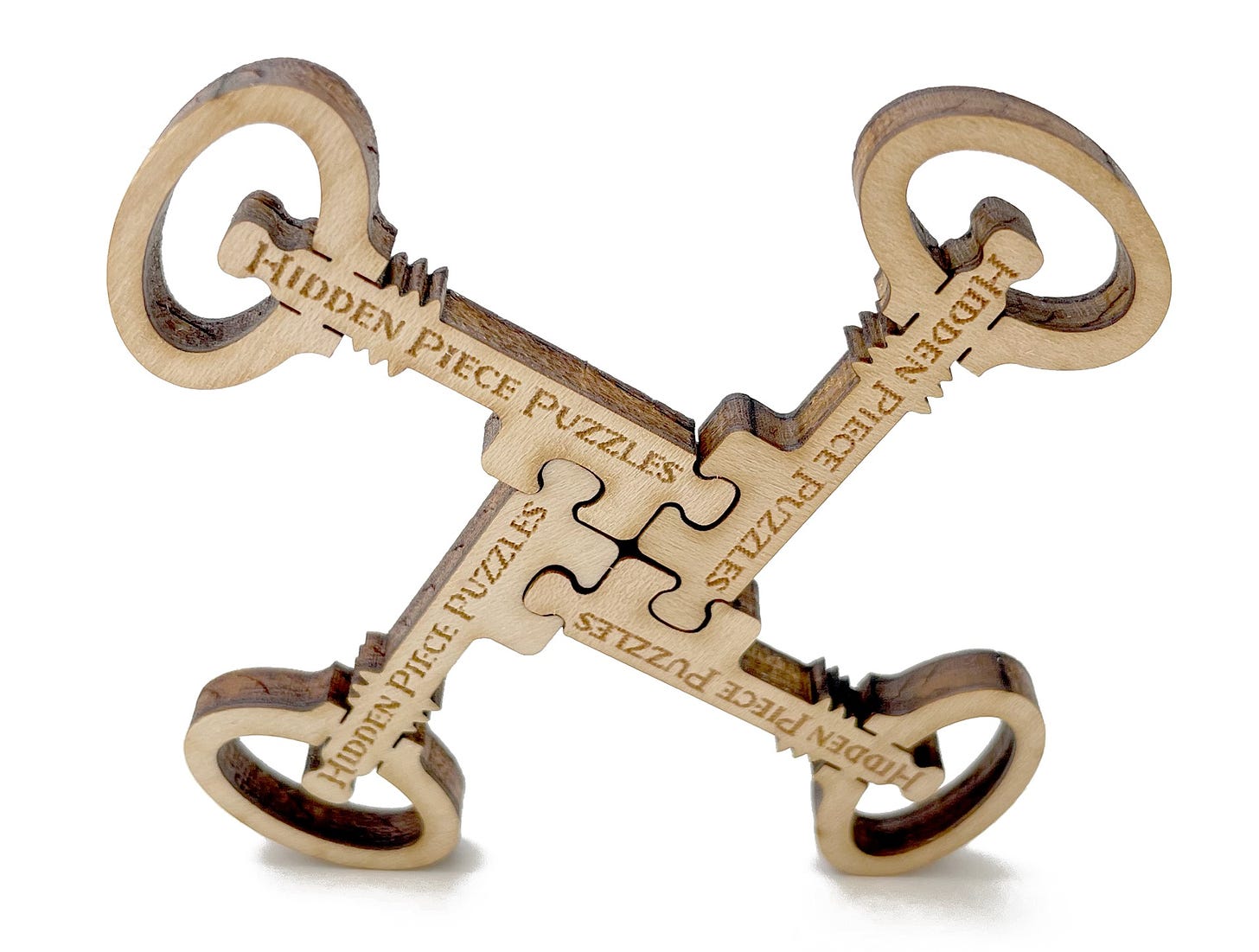
Thanks, Greg. I must admit that I feel pretty proud of this one, and I’ve got good content for Part 2 as well. It is mostly written but I am currently trying to get further biographical information about one of the artists.
Great review Bill as usual! This is impressive work from Hidden Puzzles.